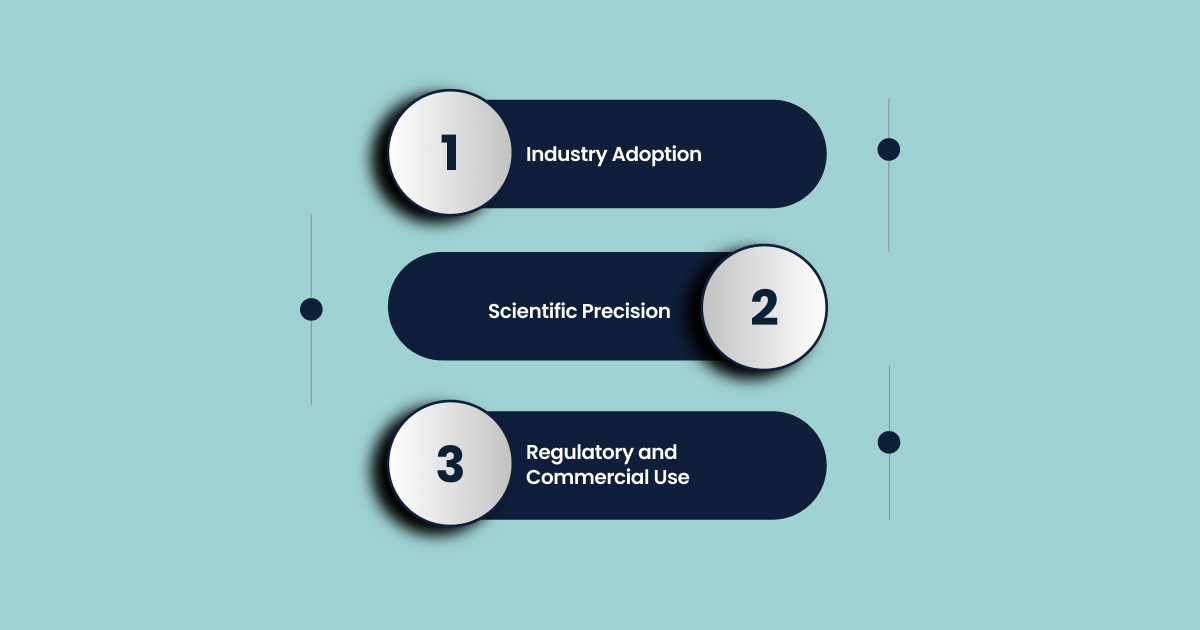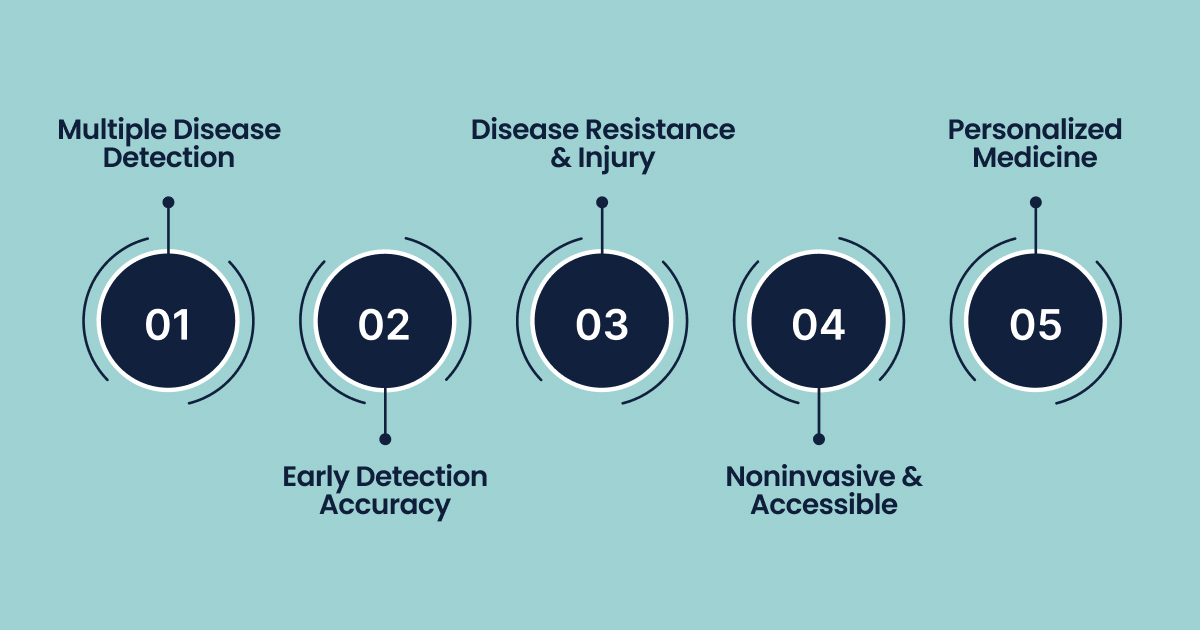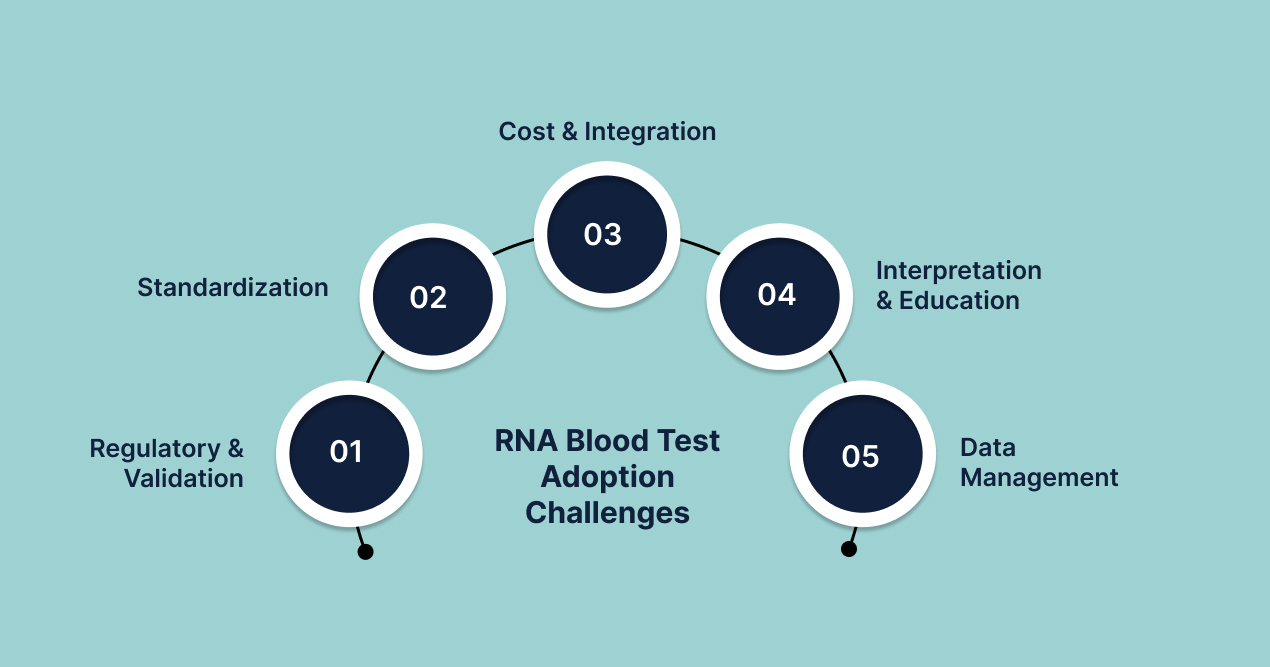Traditional disease detection methods often identify conditions after significant pathological changes have occurred, limiting therapeutic intervention windows and compromising patient outcomes. However, recent breakthroughs in molecular diagnostics have revealed a game-changing approach: RNA blood tests.
Stanford Medicine researchers have demonstrated that RNA blood tests can identify lung cancer in 73% patients, including those in early stages, marking a significant advancement in non-invasive disease detection capabilities.
The global RNA sequencing market is projected to grow from $4.3 billion in 2024 to $10.3 billion by 2029, with a compound annual growth rate of 19.1%. This reflects the industry’s recognition of RNA-based diagnostics as a cornerstone technology for next-generation healthcare solutions.
In this article, we explore how RNA blood tests are reshaping disease detection paradigms and analyze the technological frameworks that make early intervention possible across diverse therapeutic landscapes.
Key Takeaways
- RNA blood tests can simultaneously screen for cancer, infectious diseases, autoimmune conditions, and neurological disorders, creating comprehensive diagnostic profiles that inform treatment strategies.
- RNA biomarkers provide precise molecular endpoints for clinical trials, accelerating drug discovery timelines and improving therapeutic target identification for pharmaceutical companies.
- Advanced RNA sequencing technologies now deliver clinical-grade results at unprecedented price points, making personalized medicine accessible for large-scale population screening and therapeutic monitoring.
- Early adopters of RNA blood testing technologies gain significant market positioning advantages in personalized medicine, companion diagnostics, and the development of precision therapies.
What is an RNA Blood Test and How Does This Work?
The term “RNA blood test” commonly refers to technologies that detect and analyze RNA molecules circulating in the blood. In most recent biomedical and industry settings, the key analyte is cell-free RNA (cfRNA). These are RNA fragments released by cells into the bloodstream, rather than RNA contained inside whole blood cells.
Why Experts Focus on cfRNA in “RNA Blood Tests”?

- Industry Adoption: The breakthrough in disease detection comes from the ability to non-invasively analyze cfRNA using blood samples. These tests can detect dynamic changes in gene expression related to various disease states.
- Scientific Precision: Whole-blood RNA tends to reflect the transcriptome of circulating leukocytes only, which may not represent systemic disease. cfRNA, on the other hand, reflects transcripts from multiple tissue sources, capturing disease signatures otherwise missed by cell-based RNA assays.
- Regulatory and Commercial Use: Most FDA-cleared, CE-marked, or CLIA-launched “RNA blood tests” for cancer, infection, or other diseases are based on cfRNA detection because of their specificity and scalability.
For pharma and biotech executives, the upshot is twofold:
- Faster, broader market access as regulators clear cfRNA tests for early screening and minimal residual disease (MRD) use cases.
- More powerful companion diagnostics (such as Foundation One CDx tests) opportunities that align drug response with real-time biology, rather than relying on historical genotype alone.
While the technical capabilities of RNA blood testing are impressive, the applications of RNA blood tests demonstrate why leading companies are rapidly integrating RNA diagnostics into their strategic development programs.
Importance of RNA Blood Tests in Disease Detection

The strategic value of RNA blood testing extends far beyond traditional diagnostic applications, creating transformative opportunities for pharmaceutical and biotechnology companies across multiple therapeutic areas.
Detecting Multiple Diseases From a Single Blood Draw
RNA blood tests transform diagnostic workflows by identifying cancer biomarkers, infectious disease signatures, autoimmune indicators, and neurological dysfunction patterns within integrated analytical frameworks.
Oncology: Expanded Reach and Early Diagnosis
- Stanford Medicine’s 2025 pan-cancer cfRNA panel demonstrated 95% accuracy for cancer detection across multiple stages using a simple blood test. This is a clear leap for pharma partners seeking Multi-Cancer Early Detection (MCED) tools that are actionable at the population level.
- Geneoscopy’s newly FDA-approved ColoSense stool RNA assay achieves 93% sensitivity for colorectal cancer and 100% for Stage I, giving drug developers and screening programs unprecedented diagnostic leverage for targeted enrollment and monitoring.
- Exai Bio’s RNA-based liquid biopsy platform has informed real-time therapy stratification in breast cancer in the I-SPY 2 trial, in collaboration with Quantum Leap Healthcare Collaborative (QLHC). This helps sponsors and CROs adaptively assign patients to the best investigational arms and de-risk pipeline assets.
Infectious Disease & Pandemic Preparedness
- A recently validated cfRNA blood signature picked up tuberculosis in high-burden countries with 97% sensitivity.
- It achieved 85% specificity for tuberculosis across Uganda, Vietnam, and the Philippines, outperforming WHO target benchmarks of many legacy DNA or protein-based diagnostics.
- During COVID-19, Illumina’s COVIDSeq viral RNA-seq test (cleared under EUA) gave a real-time readout of infection and variant tracking.
This is a key differentiator for public health preparedness and pharma’s surveillance endpoints.
Neurology and Autoimmunity
Emerging RNA blood tests catch neurodegenerative disease and autoimmune flare-ups before clinical symptoms:
- A tRNA-based panel identified Parkinson’s years before motor symptoms, quantifying transfer RNA fragments linked to mitochondrial stress.
- IQuity’s IsolateMS long-non-coding-RNA (lncRNA) panel delivers 94% diagnostic accuracy for multiple sclerosis in seven days, cutting typical diagnostic latency from months to one week.
- Blood-based biomarkers for Alzheimer’s disease now demonstrate 85-90% diagnostic accuracy.
This also illustrates how RNA technologies extend beyond oncology applications into neurodegenerative conditions.
Cardiometabolic & Pregnancy Health
- cfRNA ratios now predict adverse outcomes such as preeclampsia months before clinical onset with 83% sensitivity and 90% specificity.
- Ribosomal RNA fragments can even track myocardial infarction severity, helping cardiovascular drug programs with early, noninvasive endpoints. This gives biopharma more lead time to trial or launch preventive therapies.
The technology’s ability to detect co-occurring conditions provides critical insights for drug safety assessments, potential drug-drug interactions, and patient selection criteria that enhance clinical trial success rates.
Greater Accuracy in Early Detection
Traditional biomarkers (DNA mutations, proteins) often lag behind real cellular shifts. cfRNA provides a live readout of gene expression and pathway activity, capturing cancer and other diseases at their incipient stages or in previously “low-shedding” tumors.
For example,
- Stage-I Sensitivity Gains: University of Chicago’s RNA modification panel hit 95% accuracy for stage-I colorectal cancer, doubling cfDNA sensitivity at this stage.
- Lower False‐Negative Rates in Low-Shedding Tumors: Lung cancer pilot data showed 2,537 differentially expressed cfRNA transcripts versus 50% ctDNA sensitivity in stage I NSCLC.
- Basket Trials: Pharma sponsors leverage these quantitative RNA-based signals to fast-track eligibility screening for adaptive or umbrella trials, reducing screen failure rates and saving millions in trial costs.
- MRD Monitoring: Inocras’ MRDVision whole-genome cfRNA/cfDNA platform achieved a 1 ppm limit of detection without patient-specific panels. This supports faster post-surgical surveillance than DNA-only solutions.
Companies positioning themselves in these emerging markets gain substantial competitive advantages as healthcare systems increasingly prioritize prevention-focused approaches.
Detecting Disease Resistance and Tissue Injury
RNA blood tests excel at identifying therapeutic resistance mechanisms and tissue-specific injury patterns that guide treatment optimization strategies. For example;
- Stanford’s cfRNA panel simultaneously tracked EGFR-T790M and MET-amp-associated resistance transcripts for lung cancer three months before radiological evidence.
- This guided the switch of osimertinib to amivantamab three months earlier than radiographic progression.
- Exai Bio’s oncRNAs flagged non-responders to neoadjuvant HER2 blockade within three weeks. This provides an actionable biomarker for dose adjustment or the introduction of next-generation agents.
Biotech and pharma companies increasingly use cfRNA to track off-target toxicity and immune-related adverse events. For example,
- cfRNA from endothelial and hepatocyte apoptosis quantified immune-related adverse-event (irAE) burden in IO trials, correlating with ALT spikes before lab thresholds.
- Plasma cfRNA profiles identified cardiotoxicity signatures during anthracycline therapy, dovetailing with the FDA’s push for early cardiac safety markers.
Such abilities of RNA blood tests directly aid risk management for high-value biologics and targeted therapies.
Noninvasive and Accessible
Currently, we need diagnostic solutions that minimize patient burden, expedite timelines, and maximize data utility. Comparing cfRNA liquid biopsy to traditional tissue biopsies and protein-only blood tests reveals why RNA blood testing is increasingly preferred throughout both development and clinical care.
| Criteria | cfRNA Liquid Biopsy | Tissue Biopsy | Protein-Only Blood Test |
| Invasiveness | Non-invasive. Routine blood draw or stool collection. Low-risk, patient-friendly. | Invasive. Requires surgical intervention or core-needle sampling. Risk of complications. | Non-invasive. Blood draw, but it only offers limited functional insight. |
| Industry Impact | Easier patient recruitment, higher trial retention, and broader adoption. | Increased patient discomfort, potential complications, and limited repeatability. | Limited diagnostic value due to restricted molecular data. |
| Sample Turnaround | Results in under 72 hours for rapid clinical decision-making. | Results often take 1-2 weeks due to complex workflows. | Results are typically available within 24 hours but are limited in scope. |
| Industry Impact | Speeds trial logistics, reduces patient anxiety, and minimizes lost-to-follow-up. | Delays in treatment start and trial enrollment are impacting operational efficiency. | Faster results, but limited clinical value. |
| Repeatability | Can be performed frequently (even weekly) for monitoring disease progression and treatment response. | Rarely repeatable due to patient discomfort and risk. | Repeatable but lacks sensitivity for early molecular changes. |
| Industry Impact | Essential for adaptive trials, precision medicine, and longitudinal studies. | Limited repeatability hinders dynamic monitoring and adaptation in trials. | Limited sensitivity for early-stage changes or minimal disease. |
| Multi-Analyte Content | Provides a holistic view, detecting gene expression, splicing, fusions, and pathway-level activity from one sample. | Limited by access, sample heterogeneity, and procedural risks. Multiple tests are often required. | Restricted to a few protein markers, lacking molecular insight. |
| Industry Impact | Enables multi-arm trials, real-time biomarker discovery, and comprehensive patient stratification. | Accessing multiple pathways often requires separate tests, increasing complexity. | Restricts tailored therapy and biomarker identification, limiting trial flexibility. |
Strategic partnerships, such as those between Pillar Biosciences and AstraZeneca on kitted cfRNA NGS panels and Guardant and Bayshore for home phlebotomy MCED rollout, are expanding reach far beyond major hospitals into community settings and decentralized trial networks.
This accessibility enables widespread screening programs, longitudinal patient monitoring, and point-of-care applications that expand market opportunities for diagnostic and therapeutic companies.
Personalized Medicine Potential
RNA blood testing provides the molecular granularity required for precision medicine approaches that optimize therapeutic outcomes through individualized treatment strategies. For example,
- Roche’s 2025 FDA-cleared VENTANA Kappa/Lambda Dual ISH mRNA assay stratifies B-cell lymphomas by light-chain expression, guiding anti-CD20 dosing regimens. This is a model for integrating cfRNA into routine clinical decision-making and regulatory submissions.
- Genomic Testing Cooperative’s Liquid Trace pan-cancer cfRNA+cfDNA test, now with UKCA mark, enables therapy selection for EU oncology trials.
- CircNova’s NovaEngine designs therapeutic circular RNAs via deep learning, compressing lead-asset generation from nine months to six weeks.
- GeneCentric’s Tumor Functional Taxonomy platform raised $8 million to integrate cfRNA signatures into trial biomarker strategies for PD-1/L1 combinations.
- Real-time cfRNA MRD endpoints allow pharma sponsors to pivot dose cohorts mid-study, maximizing the Probability of Technical Success (PTS).
- In a pilot pancreatic-cancer study, Geneseeq’s cfRNA fragmentomics assay revealed subclonal resurgence at 4 weeks, prompting on-protocol escalation.
These are examples of how RNA blood tests are useful for multi-tumor therapy selection, along with aligning with global regulatory trends.
As these diagnostic capabilities mature, they create new paradigms for therapeutic development that prioritize molecular precision over broad-spectrum approaches, fundamentally reshaping how companies approach drug discovery and clinical development strategies.
However, realizing these transformative benefits requires navigating a complex landscape of implementation hurdles that currently limit widespread adoption. Understanding these challenges becomes essential for companies seeking to capitalize on RNA blood testing opportunities while developing realistic deployment strategies.
Challenges in Clinical Adoption of RNA Blood Test

Despite the transformative potential of RNA blood testing, several implementation challenges must be addressed to achieve widespread clinical adoption and commercial success in pharmaceutical and biotechnology markets.
- Regulatory Complexity and Validation Requirements
RNA blood tests must meet strict regulatory standards. They require thorough clinical validation, standardized procedures, and proof of clinical usefulness across diverse patient groups.
Agencies need solid evidence of test accuracy and reliability before approval. Companies face complex regulations and must invest heavily in clinical trials and regulatory expertise to gain market approval.
- Technical Standardization and Reproducibility
RNA molecules are unstable, which complicates sample collection, processing, and analysis. Variations in how samples are handled, stored, and analyzed can affect test results, making it harder to rely on them clinically.
Industry-wide efforts to standardize procedures and improve reproducibility are crucial, but they require significant resources and collaboration.
- Cost-Effectiveness and Healthcare Integration
Although RNA sequencing costs are dropping, they remain a barrier to widespread clinical use. Healthcare systems need clear proof that RNA tests are cost-effective and improve patient outcomes.
Companies must show that the benefits outweigh the costs and that the tests integrate seamlessly into healthcare workflows.
- Clinical Interpretation and Physician Education
RNA data interpretation is complex, and many healthcare providers lack the expertise to use the results effectively. To bridge this gap, companies need to develop education programs, decision support tools, and resources to help physicians interpret RNA test results. These programs require substantial investment.
- Data Management and Bioinformatics Infrastructure
RNA testing generates large datasets that require advanced bioinformatics tools and infrastructure. Healthcare organizations must invest in technology and expertise to manage and analyze this data effectively.
Without the right systems in place, utilizing RNA tests to their full potential becomes a challenge.
Addressing these multifaceted challenges requires innovative solutions that simplify implementation while maintaining analytical rigor.
The most successful approach would be to integrate technical excellence with user-friendly interfaces. This can make advanced RNA sequencing accessible to organizations regardless of their internal bioinformatics capabilities.
How Biostate AI Streamlines RNA-Sequencing Analysis For You
RNA sequencing has long been complex, requiring specialized labs, bioinformatics expertise, and costly resources. This has limited accessibility for researchers and clinicians.
Biostate AI changes this by offering a streamlined, integrated platform that simplifies the entire RNA sequencing process, making high-quality results faster and more affordable.
Key platform capabilities:
- Complete Workflow Integration: From sample collection to analysis, we handle the entire process with standardized protocols for consistent, reproducible results across all applications.
- AI-Enhanced Analysis: OmicsWeb AI offers intuitive data exploration with natural language queries, automated pipelines, and ready-to-publish visualizations—no bioinformatics expertise needed.
- Exceptional Cost Efficiency: Get high-quality RNA sequencing starting at $80 per sample, making it accessible for large studies, clinical trials, and diagnostics.
- Rapid Turnaround: Results delivered in 1–3 weeks, ideal for time-sensitive research, clinical decisions, and therapeutic monitoring.
- Advanced Sample Compatibility: Handle small sample volumes (10µL blood, 10ng RNA) and degraded samples (RIN as low as 2), expanding the possibilities for challenging clinical and research conditions.
- Disease Prediction Integration: Biobase AI uses RNA data to provide accurate disease predictions and therapy guidance, enhancing research and therapeutic applications.
Biostate AI simplifies the complexity of RNA sequencing, delivering enterprise-grade analysis that meets the needs of pharmaceutical research, clinical trials, and diagnostics.
Final Words
RNA blood tests are revolutionizing disease detection, moving from traditional symptom-based diagnosis to molecular-level insights.
For pharmaceutical and biotech companies, the potential goes beyond diagnostics. RNA blood testing opens doors to targeted drug development, companion diagnostics, and personalized treatments. This can give businesses a competitive edge in clinical trial design, patient selection, and therapeutic optimization.
Biostate AI’s RNA sequencing platform offers clinical-grade results starting at just $80 per sample. With rapid turnaround times, our solution makes advanced molecular diagnostics accessible to organizations of all sizes.
By combining state-of-the-art sequencing technology with AI-driven analysis, we provide actionable insights without the need for specialized bioinformatics knowledge or expensive infrastructure.
Want to enhance your research with RNA sequencing? Contact us to learn how Biostate AI can help accelerate your projects with high-quality RNA sequencing tailored to your needs.
FAQs
1. Can RNA blood tests replace traditional biopsy procedures for drug development studies?
While RNA blood tests cannot completely replace tissue biopsies for all applications, they significantly reduce the need for invasive procedures in many research contexts. For longitudinal monitoring, treatment response assessment, and early-phase clinical trials, RNA blood tests provide comparable molecular insights with improved patient compliance and reduced procedural risks, making them ideal for serial sampling protocols.
2. How do regulatory agencies view RNA blood tests for clinical trial endpoints?
Regulatory agencies increasingly recognize RNA biomarkers as valid clinical trial endpoints, particularly for early-phase studies and companion diagnostic development. The FDA has approved several RNA-based diagnostic tests, and agencies provide clear guidance pathways for companies developing RNA biomarker assays. However, each application requires specific validation studies demonstrating clinical relevance and analytical performance.
3. What is the cost difference between RNA blood tests and comprehensive genomic profiling?
RNA blood tests typically cost significantly less than comprehensive tissue-based genomic profiling, with platforms like Biostate AI offering results at $80 per sample compared to $3,000-5,000 for traditional comprehensive genomic profiling. This cost advantage enables larger study cohorts, more frequent monitoring, and broader patient access while providing complementary molecular information.
4. How do RNA blood tests integrate with existing clinical trial data management systems?
Modern RNA blood testing platforms provide standardized data outputs compatible with common clinical trial data management systems through secure API connections and standardized file formats. Integration typically requires minimal infrastructure changes. Platforms like Biostate AI offer direct integration capabilities that streamline data transfer and analysis workflows for clinical research applications.
